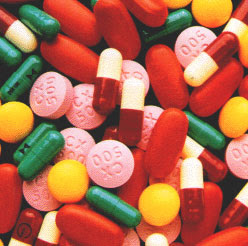If all medicine is originally from herbs, why not just use herbal medicine instead of pharmaceutical medicine with harmful additives?
The doctors have given a great overview on the safety of additives and the potential harm from herbal medicines.
But why not just extract the natural product and use that natural compound?
To explain, we have to go back to the start of the biochemical engineering industry which had its roots in the development of penicillin.

Structure of penicillin
Production and Scale-up of Penicillin
After the well known story of Alexander Fleming and his moldy plates, the antibiotic's importance in infectious disease quickly took off and the US and British Government quickly made it a priority to produce large quantities. The original method of penicillin production was to grow massive quantities of fungi and subsequent extraction. It was a long, extremely expensive, and low yield process with multiple quality control issues.
“The mold is as temperamental as an opera singer, the yields are low, the isolation murder, the purification invites disaster. Think of the risks!”
-Jasper Kane

A female laboratory worker sprays a solution containing penicillin mould into flasks of Corn Steep medium, to encourage further penicillin growth. The spore suspension contained in the spray gun contains dust taken from the new mould which has been grown in test tubes from Professor Fleming's original mould.[1]
It wasn't until the development of fermentation by some company called Pfizer when they were able to engineer a process that took their gluconic acid and vitamin C process using deep-tank fermentation and extended it to penicillin. The first penicillin plant was built in 1944 with several 7,500 gallon tanks. In 1942, there was enough drug to for ten doses, by 1945 there was enough to treat 646 billion. [2]

Pilot plant production [3]
Derivatives of Penicillin
Penicillin is part of a broad class of antibiotics known as beta-lactams which inhibit cell wall synthesis in bacteria. However, the beta-lactam ring is extremely unstable as the strained ring will have a large tendency to open. Furthermore, penicillin was limited to Gram-positive bacteria. Fortunately, due to the work of organic chemist John Sheehan, the total snythesis of penicillin was determined and further derivatives of the compound could be designed.

Structures of the b-lactam ring in red
One of the earliest derivatives was Ampicillin which not only attacks Gram-positive organism but also Gram-negative organisms. It's development in 1961 by a company named Beecham (now known as GSK) expanded the range and class of infections doctors may not attack. The key difference between the two molecules is the presence of the amine (-NH2) at the end of the molecule next to the benzene ring (go ahead, check for yourself). The whole class of compounds known asAminopenicillins allows for the drug to penetrate the outer membrane of gram-negative cells.

Structure of Ampicillin
Ampicillin isn't ideal for pills as it isn't well absorbed with a bioavailability of 40%. As a result, taking a pill based version meant that patients would have to take twice as much drug to get the appropriate dose. A subsequent version of the compound,Amoxicillin, was designed this time changing the benzene to a phenol. The addition of the hydroxyl group (-OH) now increases the bioavailability to 95% allow it to be taken orally in a pill/capsule/tablet form.

Structure of Amxocillin
Sometimes that might not be enough! Bacampicillin has an additional glycol chain to make it a prodrug with increased bioavailability

Structure of Bacampicillin
Many biologists don't actually use Ampicillin since it is fairly unstable. Instead Beecham designed a class of penicillin known as Carboxypenicillin, which has a carboxylic acid group (-COO) instead of the amino group . This increases the water stability of the drug, increases the solubility, and the byproducts tend to be less toxic. Unfortunately, they are limited to Gram positive cells.

Structure of Carbenicillin
Overcoming drug resistance
The bugs have evolved resistance to the drug with the advent of beta-lactamaseswhich generally hydrolyze the beta-lactam ring resulting in the lost of potency.

Mechanism of lactamase activity
The first group of compounds that overcame this activity were the Cephalosporin which came from another fungus and was ultimately developed by Eli Lilly. These compounds introduce an extended ring which stablizes the beta-lactam. There are now 5 generations of this compound and the latest group is currently MRSA effective.

Structural differences between penicillin (1) ad cephalosporins (2)
As the beta-lactamases continued to evolve, an entire new class of compounds,Carbapenem, were developed with even a more different core. Now, the sulfur (S) has been removed and a double bond has been introduced. Unfortunately, these compounds have poor bioavailability and will have to be delivered intravenously. As a result, these compounds serve as a last resort antibiotic. Merck, AstraZeneca, Daiichi all have versions of the drug.

Structure of Carbapenems
Specificity of antibiotics
Everything I have written so far has been about broad spectrum antibiotics. However, as noted in Christopher VanLang's answer to Antibiotics: If I was completely selfish and cared nothing for society, should I care if my doctor over-prescribes antibiotics?it isn't a great idea to completely wipe out your gut biome. As a result, it is often desirable to use a narrow-spectrum antibiotic. Medicinal chemists can do this by changing the specificity of the compound by adding functional groups that will by recognized by certain desired bacteria.
For instance we have
Gram-negative only with Phenoxymethylpenicillin

Syphilis with Benzylpenicillin

Rheumatic fever and Syphilis with Benzathine benzylpenicillin

Strept infections Propicillin

Gut only with Metampicillin

Gram positive only & staph with Cloxacillin

Making and approving the Drug Product
The FDA will ultimately not approve a drug but actually the drug product. This is the final form that ultimately goes to and into the patient and includes tablet, the needles, and all of the excipients that added to the drug. Key things include
- pH of the drug
- particle size of the granuales
- density
- stabilizers
- binders
- lubricants
- fillers
- tempertaure stability
- water stability
- color of the outside
- taste of the pill
- shape of the pill
- size of the pill
These components are all part of the quality control of the drug and ensures that when they get shipped India, they still work. For patients that take a lot of daily drugs, the color, shape, and size enables them to tell the difference. Things like dosing regiments, taste, and chewablity affect patient compliance. The pH of the compound influences details as specific as whether the drug gets absorbed in the stomach or the small intestine.
Depending on the use of the drug, different delivery mechanism will have to be considered. If there is a skin infection, maybe an ointment will be use. Babies and certain disabled people won't be able to eat a pill so a liquid or injectable version will be designed.
Drug making as a whole
The point of making derivatives is to give a drug properties that didn't originally exist with the older compound.
- Sometimes, the drug can be made safer.
- Sometimes, the drug can be made more potent.
- Sometimes, the drug can be made to overcome antibiotic resistance.
- Sometimes the drug can be made to last longer, most stable, or eatable.
- Sometimes the drug can be made more inexpensive so that they can be given to the third world.
To be frank, there is a lot of things that we don't know in the drug making world. There will be mechanisms that are unknown, side effects that can't be predicted, compounds that refused to be synthesized. But it remains the priority and the goal of drug makers to get treatments to patients in a safe and efficacious manner and if it involves making safer, more potent, inexpensive synthetic compounds, we will do it.
For fun, here is an entire List of β-lactam antibiotics

The β-lactam core structures. (A) A penam. (B) A carbapenam. (C) An oxapenam.(D) A penem. (E) A carbapenem. (F) A monobactam. (G) A cephem. (H) A carbacephem. (I) An oxacephem.
Generic Antibiotics Online
 "Billions wasted on pricey drugs" was the headline in the newspaper some time ago. Medicare claims that the program is wasting hundreds of millions of dollars because doctors continue to prescribe and patients continue to ask for pricey name brand drugs when
"Billions wasted on pricey drugs" was the headline in the newspaper some time ago. Medicare claims that the program is wasting hundreds of millions of dollars because doctors continue to prescribe and patients continue to ask for pricey name brand drugs when  In study of 6 million ED patients, 75 percent either didn't receive or fill prescriptions.
In study of 6 million ED patients, 75 percent either didn't receive or fill prescriptions. A diet that's bad for a man's heart is also not good for his ability to have erections.
A diet that's bad for a man's heart is also not good for his ability to have erections. High cholesterol or high blood pressure can damage blood vessels, including those that bring blood to the penis. Eventually, this may lead to ED.
High cholesterol or high blood pressure can damage blood vessels, including those that bring blood to the penis. Eventually, this may lead to ED. Strong evidence links a sedentary lifestyle to erectile dysfunction. Running, swimming, and other forms of aerobic exercise have been shown to help prevent ED.Watch out for any form of exercise that puts excessive pressure on the perineum, which is the area between the scrotum and anus. Both the blood vessels and the nerves that supply the penis can be adversely affected from excessive pressure in this area. Goldstein says bicycle riding, in particular, can cause ED.
Strong evidence links a sedentary lifestyle to erectile dysfunction. Running, swimming, and other forms of aerobic exercise have been shown to help prevent ED.Watch out for any form of exercise that puts excessive pressure on the perineum, which is the area between the scrotum and anus. Both the blood vessels and the nerves that supply the penis can be adversely affected from excessive pressure in this area. Goldstein says bicycle riding, in particular, can cause ED. Believe it or not, some cases of erectile dysfunction stem from penile injuries that occur during sex. Taking your time and avoiding certain positions can help. It may be uncomfortable, but consider talking to your doctor about what to do and, more importantly, what not to do.
Believe it or not, some cases of erectile dysfunction stem from penile injuries that occur during sex. Taking your time and avoiding certain positions can help. It may be uncomfortable, but consider talking to your doctor about what to do and, more importantly, what not to do. Taking the erectile dysfunction drug
Taking the erectile dysfunction drug  Israel's medical-marijuana industry is thriving, and the Israeli government is funding breakthrough research on the healing potential of the cannabis plant.
Israel's medical-marijuana industry is thriving, and the Israeli government is funding breakthrough research on the healing potential of the cannabis plant.